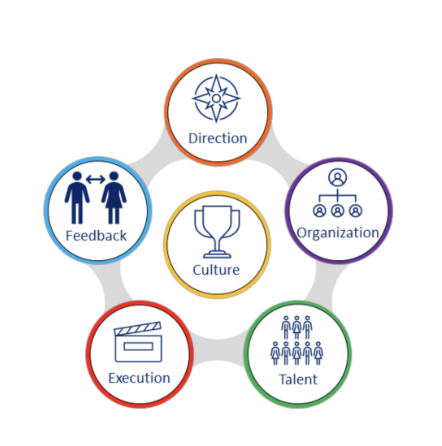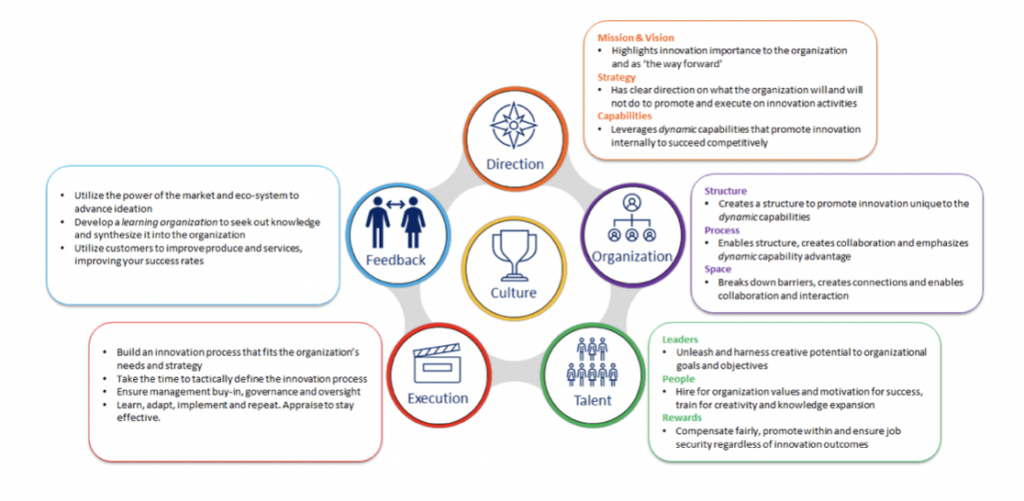In the past 20 years, the word ‘innovation’ has developed a notorious reputation in business; it is a word that can simultaneously trigger emotions in leaders, from hope to terror. The reason; Innovation for many organizations is nebulous, future-oriented and (at times) can be risky. But the truth is innovation is necessary in today’s business world. Globalization and digitalization are putting unprecedented pressure on the profitability of many businesses. At the same time, successfully innovative organizations have grown by up 84% over the past five years, setting the stage for organizations to adopt innovation and become future-ready.
When discussing innovation, we are not solely speaking about setting up special teams to ‘own’ it or developing new products and services.
To us at Stack’d, true innovation is about harnessing organizational culture; it is an organization’s ability to adapt and maximize its internal capabilities to create a unique competitive advantage and foster new growth.
In order for organizations to remain competitive and be future-ready, leaders have to identify and embrace what defines their organization’s core competencies and cultivate an innovative culture.
Connective Framework to Innovation
What exactly does an innovative culture look like? While it is unique to each organization, it can be broken down into observable and definitive parts. We have defined these pieces as our connective framework to innovation. We will explore the model to build out the core and periphery requirements when cultivating innovation. The connective framework is an integrative model of five elements; Direction, Organization, Talent, Execution, Feedback.

- Direction – Direction is the strategic guide of the organization. Direction includes mission and vision, organizational strategy, and supporting capabilities.
- Organization – Organization defines the tangible construct of the connective model. Organization includes organizational structure (i.e. the boxes and wires), processes, and space (i.e. the physical layout an organization operates within).
- Talent – Talent emphasizes the people of the connective model. Talent is crucial because the human element drives organizational creativity and executes the innovation process. Talent includes Leaders, People and Rewards.
- Execution – Execution is the engine of the connective framework. Execution is the process by which the organization transforms ideas into products and services.
- Feedback – Feedback is the response of the connective framework. Feedback emphasizes the importance of responsiveness to an innovative culture.
These five elements must work together in alignment to generate the organization’s core culture of innovation. Each is connected and equal, implying that the model can not function if points of the framework are missing or misaligned. Without all five elements, the model will not work. Subsequently, the model will be distorted or fragmented if there is too little or too much emphasis on any one element.
Tesla provides a great example of organizational alignment in creating a core culture of innovation. Recently the supply of semiconductors provided another blow to the automotive sector. This shortage caused some automotive brands to come to a grinding halt in production. To combat this supply chain issue, Tesla “substituted alternative chips, and then wrote the firmware in a matter of weeks,” explained Elon Musk. Tesla was able to quickly react and respond to the supply chain issue and capitalize on its lagging competitors. The organization had built internal software capabilities which allowed for the execution of this response, but it was the organization’s core culture of innovation which derived this solution. Innovation is ingrained in their direction, their organization, attracts their talent, and guides their execution and feedback.
Choosing to adopt an innovative culture does not occur overnight. It is not a transformation that is tasked to one division or only a specific level of leadership. You will see why as we further examine each element of the connective model and their importance in enabling and sustaining a culture of innovation.

Direction
Located at the top of the connective model, Direction is the strategic guide of the organization. Direction includes mission and vision, organizational strategy, and supporting capabilities.
Mission and Vision
The mission is the organization’s purpose for existing, while the vision describes a direction; a future state of the organization. They provide a long-term outlook and let everyone internal and external to the organization know where the organization is going and how it’s going to get there. Companies that have innovative cultures emphasize innovation, creativity and exploration in their mission and vision statements and repeatedly turn to their mission and vision for direction and inspiration.
For example, Nike’s mission statement is: Bring inspiration and innovation to every athlete* in the world. (*If you have a body, you are an athlete.) In the sporting industry, Nike is setting itself apart by pushing the limits of sporting equipment and wear to help improve the performance of all athletes.
Companies with innovative cultures utilize mission and vision to highlight the importance of innovation to the internal organization, define it as the way forward and let the public know how innovation will drive organizational success .
Strategy
Business strategy is “…choices made, on where to play and how to win, to maximize long-term value“. This concept of making choices and trade-offs is critical to developing and maintaining an innovative culture because an organization can choose to pursue innovation activities or not.
Strategic choices the organization will have to consider include:
- Whether or not the organization will engage in innovation corporately.
- To what extent and what innovation activities will the organization engage in.
- Whether or not the organization will engage in innovation with the broader operating environment.
Strategy sets the direction for the organization. An organization with a culture of innovation is clear on what the organization will and will not do to promote, foster, and execute innovation as part of its direction.
Capabilities
Strategy defines what the organization will and will not do and forms the foundation for the dynamic capabilities the organization will need to execute their desired strategy.
Dynamic capabilities are the unique interplay of resource and competency that lead to competitive advantage. An organization that has a clear innovation strategy identifies and internalizes the dynamic capabilities necessary (e.g. how the organization ‘learns’, ‘invents’, ‘collaborates’, and ‘creates’) to transform knowledge into innovative products and services that the competition cannot imitate.
An organization with an innovative culture embraces, leverages, and enhances its dynamic capabilities to succeed in competitive environments.
Organization
Moving to the right, Organization defines the tangible construct of the connective model. Organization includes organizational structure (i.e. the boxes and wires), processes, and space (i.e. the physical layout an organization operates within).
Structure
As work becomes knowledge-intensive, organizations must become learning organizations that favour speed, agility, and knowledge transfer over production efficiency. These shifts make organizational structure increasingly important.
To ensure innovation, learning organizations identify integrators, communicators, and mediators. These organizational groups or individuals connect and disperse information while also filtering noise and conflict. Additionally, decentralization versus centralization of decision making, power and technical expertise, levels of organizational hierarchy, and collaboration constructs will significantly impact the effectiveness of different innovation strategies.
Learning organizations implement roles, reporting structures and integrating mechanisms to support and foster a culture of innovation.
Processes
A learning organization also considers how operating processes like communication, decision making, change management and resource allocation are conducted to ensure learning and collaboration across and within departments.
Enabling continuous learning requires processes that effectively acquire and disperse knowledge across the organization and manage change. Processes also exist to apply, adapt, and assimilate new information into the organization quickly and efficiently. Further, learning organizations integrate technical and administrative processes across departments to ensure collective objectives, benefit dynamic capabilities and align processes with strategy.
Organizations with innovative cultures ensure that processes support structure. They leverage dynamic capabilities and promote learning at technical and administrative levels.
Space
Space is the “body language” of the organization. How individuals within the organization use physical space influences individual learning and creativity, which can lead to innovation.
Creativity and innovation require interaction. Organizations enabling creativity, design spaces that maximize encounters by enhancing proximity and reducing barriers between employees and teams. Creativity also occurs through ‘spontaneous interaction’, particularly when people feel comfortable in social environments. Developing shared spaces, allowing multiple forms of representation and communication, creating formal and informal environments and promoting ease of access can also encourage creativity and innovation.
For example, to speed the innovation of their car design, BMW physically co-locates cross-functional teams at their research center FIZ for up to three years, bringing together professions like engineering, sales, marketing, manufacturing, etc. together to brainstorm, define, collaborate and operate in semi-autonomous, in person project teams. Teams are intentionally made up of team members from different operating regions of the globe to bring different perspectives and ideas from different markets to single projects. They also make decisions autonomously with minimal direction from head office. This combination of autonomous operation, decentralized decision making and physical co-location have led to many of BMW’s groundbreaking advancements and head-turning designs that delight international car shows.
Innovative cultures recognize that space is the physical manifestation of culture. Therefore, they utilize physical space to ensure encounters, collaboration, and engagement to promote creativity.
Talent
At the bottom right corner, Talent emphasizes the people of the connective model. Talent is crucial because the human element drives organizational creativity and executes the innovation process. Talent includes Leaders, People and Rewards.
Leaders
An effective culture of innovation requires effective leaders. Leaders set and interpret strategic direction, execute on organizational targets, and ensure adherence to processes that enable innovation. Most importantly, leaders affect followers’ creativity in both direct and indirect ways.
Individual creativity and creative process are inherently valuable, but their value is amplified when mobilized for organizational-level outcomes and initiatives. Leaders within the organization play the critical role of unleashing the creative potential of those they lead and harnessing that creativity towards organizational objectives. Leaders that possess the characteristics of empowerment, moral justice, behavioural consistency, creative thinking, and equality have been shown to interpret and instill attitudes and actions that promote a creative work process. Thus, enabling a ‘climate of innovation’ within their followers and organizations.
Organizations with cultures of innovation seek out, enable, promote, and invest in leaders that understand and demonstrate traits that promote creativity and good judgment in those they lead.
People
People are the heart of the organization. They generate the creativity that promotes innovation and, individually and collectively, interprets organizational structure, process, strategy, and direction to develop culture.
Creativity is a skill available to all individuals if the social environment, domain-relevant skills, enabling processes and intrinsic motivation are all present to do so. While people observe and are shaped by the environment in which they live, they flourish most in environments where personal motivations align with those of the environment. This has two implications for people. Firstly, creativity can be enhanced and taught, but intrinsic motivation cannot. Secondly, while you can hire for creativity and motivation, innovation will not naturally follow if the appropriate structures, processes, and channels are not in place.
Organizations with a culture of innovation identify and retain people with the same values and beliefs as the organization. As a result, they play to individual motivations, support behaviours that enhance innovation, and provide means for knowledge and creativity to flourish.
Rewards
While historically linked to promoting the ‘right’ behaviours and actions, rewards are counterproductive. Extrinsic motivation and reward can be detrimental to creativity and lower intrinsic interest. Individuals within knowledge environments are motivated by the challenge of their work and its perceived value to the organization.
Organizations with cultures of innovation ensure positive behaviours, attitudes and actions through fair compensation, promotion, and job security. They avoid incentive-based rewards programs and provide challenging work and opportunities to build knowledge.
As a practical example of Talent and innovation, Google’s original idea of “20% time” has found significant success across the technology space, if applied in different manners (e.g. Hackathons, Friendly Development Competitions, Pet Project Week, etc.) The idea, though, always remains the same, if you give people free time to work on what they are passionate about to improve the company or product rather than forcing them to think up “innovations”, you will likely be surprised by what people come up with and what they think is important. Just remember, coming up with a new idea is only half the battle; the other is executing when those good ideas occur.
Execution
At the bottom left, execution is the engine of the connective framework. Execution is the process by which the organization transforms ideas into products and services. An example of an innovation process is shown in Figure 3.

While the innovation process should fit the unique situations of the organization, specific features can better enable an innovative culture.
Innovation Process
The organization must first ensure that an innovation process is present. Many organizations attempt to innovate without a process. The requirements of the innovation process must be defined tactically. Specifically: how it will work, who will be involved and whether it will be organization-closed or open to the surrounding ecosystem. As an example, Procter and Gamble actively partners with universities and government labs. Relying on their “technology entrepreneurs” to engage with the broader ecosystem and identify new ideas and scientific discoveries. While some decisions are strategic elements, the innovation process is the execution of strategy. Tactically defining the innovation process will ensure clarity and reduce the ambiguity that stifles creativity and innovation.
Management’s role in the process is also important. Management is the gatekeeper to resources and capital and can tilt the chances of ideation success. Unfortunately, managers are also influenced by political, monetary, and operational incentives. An effective innovation system applies appropriate checks, balances, and governance mechanisms to ensure innovation independence.
Mechanism for Appraisal
Lastly, the process needs a mechanism for appraisal. As knowledge is gained from innovation efforts, the organization must learn and adapt to what works and what does not throughout the process and in the result. The entire organization must commit to adopting learning into the innovation and supporting processes to remain effective.
Organizations with cultures of innovation have a tactically clear innovation process that is widely understood and accepted. Clear boundaries promote checks and balances, while organizational learning ensures the process adapts to organizational and environmental changes.
Feedback
On the far left, Feedback is the responses of the connective framework. Feedback emphasizes the importance of responsiveness to an innovative culture.
Feedback includes the:
- Environment, whereby strategy adapts based on ecosystem and the market conditions;
- Organization, whereby knowledge is interpreted, assimilated, and internalized; and
- Customer, whereby products and services shift to meet customer outcomes and desires.
Environment
Feedback from the market and ecosystem can be a wealth of positive collaboration. Open innovation within an ecosystem can significantly advance ideation and creativity within an industry. While closed innovation systems may suffer from a lack of market knowledge.
Organization
Feedback from the organization is how the organization adopts knowledge and best practices to foster a culture of creativity through actions, behaviours and culture.
Customer
Feedback from customers extracts value to develop better products and services by evaluating customer outcomes and desires. Just remember, customers do not know what the end solution should be, even if they think they do. What customers know well is the desires and outcomes they want that end solution to give or achieve for them.
An example is the medical device company Cordis Corporation, now owned by Johnson & Johnson. They utilized the desired outcomes approach when looking for new products to address their market share of angioplasty balloons for blocked arteries in cardiac patients. Using this desires and outcomes-based approach for what cardiologists, nurses and surgeons wanted to achieve before, during and after surgery led Cordis to develop what we now know as the stent – making it one of the fastest growing medical device companies in history.
Organizations with innovative cultures believe feedback is essential to the organization’s success. Therefore, they view their surroundings and effectively internalize feedback.
Considerations for Implementation
Building a culture of innovation is complex. Each element of the connective model relies upon other elements and factors within the model, and they are not mutually exclusive. Implementing a culture of innovation is a challenging but rewarding process.
To effectively implement this model, the organization must begin with a commitment. An organization cannot ‘try out’ innovation to see if it works. It is a journey that requires the whole organization to commit to continuous learning, development, and improvement. It also requires total organizational effort. There cannot be a singular ‘office of innovation.’ An innovative culture requires full organizational buy-in and effort to implement. It starts with a leadership commitment and cascades with buy-in from the organization.
A culture that is ‘creative’, ‘innovative’, ‘continuously learns’ requires ‘the way we do things around here’ to embody these values across the entire organization. Only when the organization is committed and bought into the value and power of an innovative culture can it begin the journey of becoming that organization. The bottom line is that an innovative culture is good for business, shareholders, and prepares an organization to be future-ready.
The Connective Model – An Integrative Approach to Developing a Culture of Innovation(White Paper)
Who We Are
At Stack’d Consulting, we specialize in business transformation. Our team uses a human-centric approach to consulting and understands that the most successful transformations are built around the needs of your employees and customers. For more information on our services and untapping your organization’s potential, contact us.




